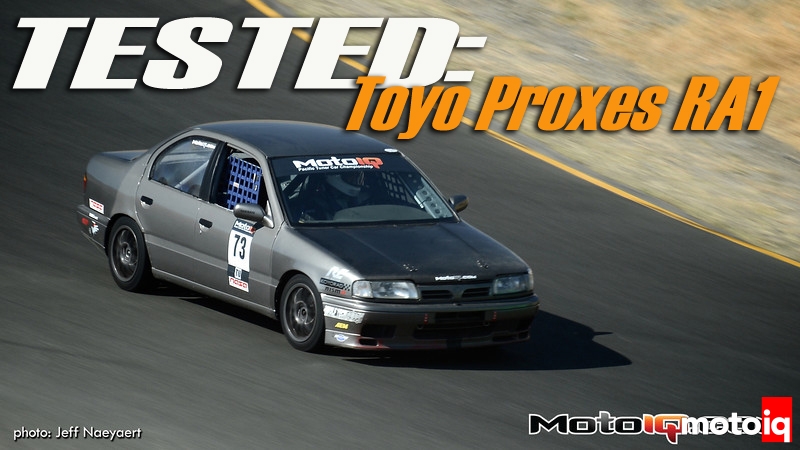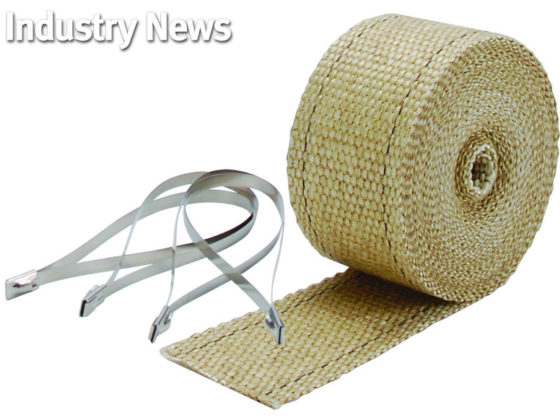,
 |
| Molded to 8/32″ tread depth, many shave them down to 4/32″ to maximize dry traction. Note the steps on the inner edge of the outer. This is the additional tread depth to increase wet traction and wears away at 6/32″ for better dry traction. |
Out on the track, I was immediately reminded of one thing: I've been racing on Toyo RA1s for a long, long, long time – my first ever competition event was on RA-1s – so I definitely did not need much in the way of acclimation to these tires. Indeed, the first thing that comes to mind is it was like hanging out with a really good friend for the first time in years: a little awkward at first, then you fall into step like you'd hung out only yesterday. Having driven nearly every R-compound tire out there, the first thing that I noticed as different about these tires was the user-friendliness of the limits. Yes, ultimate grip is lower when compared to the more aggressive, barely DOT-legal competition, but it is much easier to not only exploit what the RA1s are going to give you, but also not overdrive them accidentally. Abuse a tire for too long, and it'll wash away, but their user-friendliness allows you to spend the next lap or so nursing them back to health enough to put the hammer down again without falling too far behind.
 |
Within a handful of laps, fond memories of easily approached limits, forgiving nature, and iron-like wear surfaced.
|
 |
| Project G20 Racecar in its first race. Yep, every car in this picture is on Toyo RA1s. |
That being said, racing isn't just about how fun or easy the car is to drive, but about absolute speed. How did the RA1 stack up to other tires? Before I answer that question, I must caveat (read: spew rice lies and excuses from my lips) our results somewhat. You see, last season at California Speedway (or Auto Club Speedway) our G20 was rocking about 160whp. This season, we're pushing out 208whp, so the only fair comparison we have at this track was another California Speedway event done earlier in the year on some near-slick, barely DOT-approved competition. The rice lies come out when it comes to the way the car was set up. Since this car is a dual-driver car, the setup is different to suit each driver's tastes. Martin prefers a more stable car that is neutral under braking and pushes under throttle. I, on the other hand, prefer a car that is neutral (maybe a very slight push) under throttle, and will gladly put up with whatever rodeo action happens under braking to achieve this. Being alone at California Speedway, I didn't even stop to think that the sway bar settings had been changed and immediately blamed the push on the Toyos. Whoops. Even with what I think of as unmanageable understeer, the car still belted out a 1 minute 58.8 second lap time, only about two seconds off our previous best on stickier rubber. Fix the undiscovered handling balance issue, and we think the lap time gap would've been much closer.
 |
| Mixed up sway bar settings kept us off the podium at California Speedway. Our G20, plowing like a tractor in nearly every corner, still turned a respectable 1:58.8 lap time. |
At the next MotoIQ Pacific Tuner Car Championship (say that three times fast) event at Sonoma Raceway, the car had been returned to its optimal-for-me “bucking bronco” spec, and the Toyos really shone. During qualifying, they managed an extremely respectable 1 minute, 57.6 second lap time, putting Project G20 firmly in the number two qualifying spot by about a second. Keep in mind that due to suspension and fender clearance limitations, Project G20 is running on 225mm wide tires instead of the class limit 245mm tires that the other cars were running on.
 |
| Set up properly to my tastes, Project G20 qualified in the number two spot, despite being on tires 20mm narrower than the field. |



